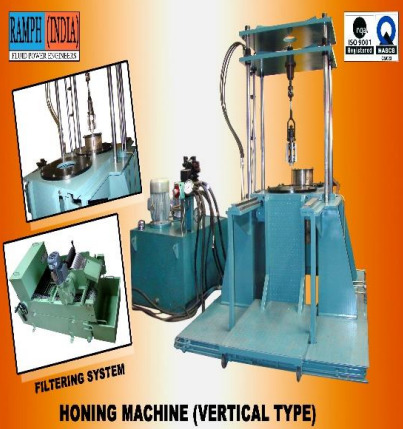Vertical Honing Machine
Vertical honing machines are precision engineering tools designed for the honing process, which is used to achieve superior surface finishes and precise dimensional tolerances on various cylindrical components. These machines play a crucial role in manufacturing industries, particularly in automotive, aerospace, and heavy machinery sectors, where high precision and surface quality are paramount.
What is Honing?
Honing is a machining process that utilizes abrasive stones or tools to improve the geometric form of a surface, enhance surface finish, and remove material from the workpiece. Unlike grinding, honing is a low-speed, high-precision process that produces a finer surface finish and tighter tolerances. The honing process is especially effective for producing features such as bores, cylinders, and other internal surfaces.
Design and Construction
Vertical honing machines are characterized by their vertical orientation, which allows for efficient chip removal and better lubrication. The design typically features a robust frame, a honing head, and a work table that can hold various workpieces. The honing head contains multiple honing stones that can be adjusted for different diameters and configurations, providing versatility in honing applications.
-
Frame and Structure: The sturdy construction ensures stability during the honing process, minimizing vibrations and enhancing precision. The vertical layout aids in effective coolant flow and chip evacuation.
-
Honing Head: The honing head is a critical component, featuring multiple abrasive stones that are mounted on a carrier. These stones can be adjusted to vary the size and shape of the workpiece being honed. The honing head can also be equipped with different types of abrasives to suit specific materials and applications.
-
Work Table: The work table is designed to securely hold the workpiece in place during the honing process. Many machines feature adjustable clamps or fixtures to accommodate different sizes and shapes of workpieces.
-
Control Systems: Modern vertical honing machines are often equipped with advanced control systems that allow for automated operation. These systems enable precise control of speed, stroke length, and pressure, ensuring consistent quality throughout the honing process.
Applications
Vertical honing machines are widely used in various industries due to their ability to produce high-quality surfaces and precise dimensions. Some common applications include:
-
Automotive Components: Honing is frequently used to finish engine cylinders, transmission parts, and hydraulic components, ensuring optimal performance and longevity.
-
Aerospace Industry: Components such as landing gear, hydraulic systems, and fuel systems require precision honing to meet strict aerospace standards.
-
Hydraulic and Pneumatic Cylinders: Honing is essential for creating the smooth surfaces needed for hydraulic and pneumatic cylinder operation, reducing wear and improving efficiency.
-
General Engineering: Various machine components, bushings, and bearings benefit from honing to achieve the desired surface finish and dimensional accuracy.
Advantages of Vertical Honing Machines
-
Precision: Vertical honing machines offer high precision and consistency, which is critical for components that require exact specifications.
-
Surface Finish: The honing process results in superior surface finishes compared to traditional machining methods, enhancing the performance and longevity of components.
-
Versatility: These machines can accommodate a wide range of materials and workpiece sizes, making them suitable for diverse applications.
-
Efficiency: With automated features and high-speed operations, vertical honing machines can increase productivity and reduce cycle times in manufacturing processes.
Conclusion
Vertical honing machines are integral to precision engineering, offering superior surface finishes and tight tolerances across various industries. Their advanced design and capabilities make them essential tools for manufacturers aiming to produce high-quality components that meet stringent performance standards. As technology continues to evolve, these machines will play an even more critical role in advancing manufacturing processes and ensuring product reliability.
